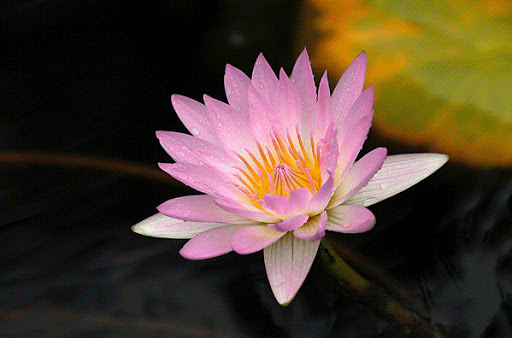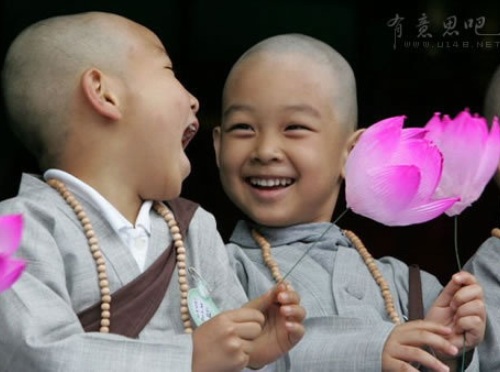If we are peaceful, if we are happy
If we are peaceful, if we are happy, we can smile and blossom like a flower, and everyone in our family, our entire society, will benefit from our peace. ~ Thich Nhat Hanh

If we are peaceful, if we are happy, we can smile and blossom like a flower, and everyone in our family, our entire society, will benefit from our peace. ~ Thich Nhat Hanh

What is lovely never dies, But passes into other loveliness, Star-dust, or sea-foam, flower or winged air. ~Thomas Bailey Aldrich

Smiling is infectious,
You can catch it like the flu.
Someone smiled at me today,
And I started smiling too.
~Author Unknown

In order to change we must be sick and tired of being sick and tired. ~Author Unknown


Photo credit: Randy Neufeldt
In the beginning we learn what still water is like and what flowing water is like. After practicing for a while we will see how these two support each other. We have to make the mind calm, like still water. Then it flows. Both being still and flowing: this is not easy to contemplate.
We can understand that still water doesn’t flow. We can understand that flowing water isn’t still. But when we practice we take hold of both of these. The mind of a true practitioner is like still water that flows, or flowing water that’s still. Whatever takes place in the mind of a Dhamma practitioner is like flowing water that is still. To say that it is only flowing is not correct. Only still is not correct. But ordinarily, still water is still and flowing water flows. But when we have experience of practice, our minds will be in this condition of flowing water that is still.
This is something we’ve never seen. When we see flowing water it is just flowing along. When we see still water, it doesn’t flow. But within our minds, it will really be like this; like flowing water that is still. In our Dhamma practice we have samādhi, or tranquility, and wisdom mixed together. We have morality, meditation and wisdom. Then wherever we sit the mind is still and it flows. Still, flowing water. With meditative stability and wisdom, tranquility and insight, it’s like this. The Dhamma is like this. If you have reached the Dhamma, then at all times you will have this experience. Being tranquil and having wisdom: flowing, yet still. Still, yet flowing. ~Ajahn Chah
If you wish to experience peace, provide peace for another. If you wish to know that you are safe, cause another to know that they are safe. If you wish to better understand seemingly incomprehensible things, help another to better understand. If you wish to heal your own sadness or anger, seek to heal the sadness or anger of another. ~Dalai Lama

Happiness is wished for by people in the world. Suffering is not wished for. Nibbāna is something beyond wishing or not wishing. Do you understand? There is no wishing involved in Nibbāna. Wanting to get happiness, wanting to be free of suffering, wanting to transcend happiness and suffering – there are none of these things. It is peace.
As I see it, realizing the truth doesn’t happen by relying on others. You should understand that all doubts will be resolved by our own efforts, by continuous, energetic practice. We won’t get free of doubt by asking others. We will only end doubt through our own unrelenting efforts.
Remember this! It’s an important principle in practice. The actual doing is what will instruct you. You will come to know all right and wrong. ”The Brahmin shall reach the exhaustion of doubt through unceasing practice.” It doesn’t matter wherever we go – everything can be resolved through our own ceaseless efforts. But we can’t stick with it. We can’t bear the difficulties we meet; we find it hard to face up to our suffering and not to run away from it. If we do face it and bear with it, then we gain knowledge, and the practice starts instructing us automatically, teaching us about right and wrong and the way things really are. Our practice will show us the faults and ill results of wrong thinking. It really happens like this. But it’s hard to find people who can see it through.
Everyone wants instant awakening. Rushing here and there following your impulses, you only end up worse off for it. Be careful about this. ~Ajahn Chah

Verse 21: Mindfulness is the way to the Deathless (Nibbana); unmindfulness is the way to Death. Those who are mindful do not die; those who are not mindful are as if already dead.
Verse 22: Fully comprehending this, the wise, who are mindful, rejoice in being mindful and find delight in the domain of the Noble Ones (Ariyas).
Verse 23: The wise, constantly cultivating Tranquillity and Insight Development Practice, being ever mindful and steadfastly striving, realize Nibbana: Nibbana, which is free from the bonds of yoga; Nibbana, the Incomparable!
1. appamada: According to the Commentary, it embraces all the meanings of the words of the Buddha in the Tipitaka, and therefore appamada is to be interpreted as being ever mindful in doing meritorious deeds; to be in line with the Buddha’s Teaching in Mahasatipatthana Sutta, “appamado amatapadam”, in particular, is to be interpreted as “Cultivation of Insight Development Practice is the way to Nibbana.”
2. amata: lit., no death, deathless; it does not mean eternal life or immortality. The Commentary says: “Amata means Nibbana. It is true that Nibbana is called “Amata” as there is no ageing (old age) and death because there is no birth.”
3. pamado maccuno padam: lit., unmindfulness is the way to Death. According to the Commentary, one who is unmindful cannot be liberated from rebirth; when reborn, one must grow old and die; so unmindfulness is the cause of Death.
4. appamatta na miyanti: Those who are mindful do not die. It does not mean that they do not grow old or die. According to the Commentary, the mindful develop mindful signs (i.e., cultivate Insight Development Practice); they soon realize Magga-Phala (i.e., Nibbana) and are no longer subject to rebirths. Therefore, whether they are, in fact, alive or dead, they are considered not to die.
5. ye pamatta yatha mata: as if dead. According to the Commentary, those who are not mindful are like the dead; because they never think of giving in charity, or keeping the moral precepts, etc., and in the case of bhikkhus, because they do not fulfil their duties to their teachers and preceptors, nor do they cultivate Tranquillity and Insight Development Practice.
6. ariyanam gocare rata: lit., “finds delight in the domain of the ariyas.” According to the Commentary the domain of the ariyas consists of the Thirty-seven Factors of Enlightenment (Bodhipakkhiya) and the nine Transcendentals, viz., the four Maggas, the four Phalas, and Nibbana.
7. jhiyino: those cultivating Tranquillity and Insight Development Practice.
8. phusanti dhira nibbanam: the wise realize Nibbana. Lit., phusati means, to touch, to reach. According to the Commentary, the realization takes place, through contact or experience, which may be either through Insight (Magga-Nana) or through Fruition (Phala). In this context, contact by way of Fruition is meant.
9. yogakkhemam: an attribute of Nibbana. Lit., it means free or secure from the four bonds which bind people to the round of rebirths. The four bonds or yoga are: sense pleasures (kama), existence (bhava), wrong belief (ditthi), and ignorance of the Four Noble Truths (avijja).
While residing at the Ghosita monastery near Kosambi, the Buddha uttered Verses (21), (22) and (23) of this book, with reference to Samavati, one of the chief queens of Udena, King of Kosambi.
Samavati had five hundred maids-of-honour staying with her at the palace; she also had a maid servant called Khujjuttara. The maid had to buy flowers for Samavati from the florist Sumana everyday. On one occasion, Khujjuttara had the opportunity to listen to a religious discourse delivered by the Buddha at the home of Sumana and she attained Sotapatti Fruition. She repeated the discourse of the Buddha to Samavati and the five hundred maids-of-honour, and they also attained Sotapatti Fruition. From that day, Khujjuttara did not have to do any menial work, but took the place of mother and teacher to Samavati. She listened to the discourses of the Buddha and repeated them to Samavati and her maids. In course of time, Khujjuttara mastered the Tipitaka. Continue reading
One moment of patience may ward off great disaster. One moment of impatience may ruin a whole life. ~ Chinese Proverb

Meditation master Dejapanno, student of the most famous Meditation master Ketodhammo Som Bunthoeun.